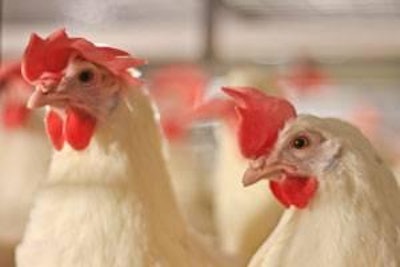
The U.S. Food and Drug Administration expects to complete its inspections of the nation’s approximately 600 egg farms with more than 50,000 layers by the end of 2011, according to Dr. Gerardo A. Ramirez, Center for Food Safety & Applied Nutrition, Office of Food Safety. Ramirez told the audience at the United Egg Producers' annual board meeting that the agency and affiliated state inspectors had completed around 300 inspections through the end of September. He said that the “600 farms” on the inspection list of egg farms include several that he called “washouts,” establishments that are on the list but are not farms. An example of a washout would be a stand-alone egg packing facility that does not have layers present on the premises, but at sometime it was registered as a farm.
Ramirez made his presentation electronically because FDA budget restrictions prevented him from attending the meeting. When asked to characterize whether or not the FDA was satisfied with the progress made by the egg industry in implementing the Egg Safety Rule, he said, “This rule is in its infancy. I couldn’t speak to whether the agency is satisfied with the industry’s actions. We are happy with the way the inspections are going. We can’t say yet whether or not the industry is giving the kind of results that the agency wants.”
Two kinds of inspections
The FDA’s on-farm inspections are intended to evaluate the farm’s SE plan implementation and compliance with the Egg Safety Rule. Ramirez said that the FDA is conducting two types of egg farm inspections in 2011, targeted and comprehensive. A risk assessment tool was used to decide if a farm gets a comprehensive or targeted inspection.
All of the inspections in 2010 were comprehensive. Targeted inspections consist of a records review and a walk through of some of the houses, no environmental samples are taken. A comprehensive inspection consists of records review, a walk-through of some of the houses and environmental swabs taken in the houses to look for SE. Targeted inspections can become comprehensive inspections if after the inspector arrives on the farm “red” flags are raised, according to Ramirez. Some states have cooperation agreements with the FDA and state inspectors are performing some of the on-farm inspections in those states. Ramirez said that state inspectors are only performing targeted inspections.
Inspection results
In the inspections conducted in 2010, Ramirez said that the biggest problem found was inadequate control of rodents on some farms. Besides the presence of too many rodents, Ramirez said that some farms were not checking rodent traps on the schedule dictated by their plan. He also said that some farms were not eliminating clutter that can serve as rodent harborage around the layer houses. Harborage needs to be eliminated by controlling vegetation growth and removing trash, implements and other items even if rodent numbers are under control.
Through the end of September of 2011, the FDA had conducted 276 inspections, 46 comprehensive and 230 targeted. An additional 31 farms had been inspected by state inspectors. On the 46 comprehensive inspections, 147 houses were environmentally sampled, and 20 of these were found to be positive for SE. But in the 147 houses, a total of 1,976 individual samples were taken, and 49 of these samples were positive. So the average positive rate for all 1,976 environmental samples was only 2.5%.
Ramirez stated that one deviation from the Egg Safety Rule that has been cited by inspectors at multiple farms has been a failure to test pullets for SE at the proper time. He said that the FDA requires that pullets are tested for SE at 14-16 weeks of age, even if you move pullets at an earlier age. Pullets need to be tested wherever they are at 14-16 weeks of age. So far in 2011, Ramirez said that the most significant findings in the inspections have been farms that don’t have an SE plan, don’t have adequate rodent and pest control programs, or don’t do environmental testing as required.
After the inspection is complete, there will be a close out meeting to go over the inspector’s observations. Ramirez stated that if deficiencies are found, a Form 483 can be issued, which can serve as a warning for items of regulatory concern. A step above receiving a Form 483 would be if the FDA issues an untitled letter. Another more serious action by the agency is the issuance of a warning letter. Ramirez said that a warning letter is a “serious notification,” and it is posted online. A warning letter requires a written response to the FDA within 15 days. The most serious outcome of an inspection would be issuance of an injunction by the FDA, or a seizure of eggs.
Notification of SE positive test
The USDA Agricultural Marketing Service requires that its graders be notified if an SE positive in-house environmental or egg sample is collected by the producer on the farm. The USDA and FDA signed a memorandum of understanding (MOU), which states that USDA will notify FDA of any SE positive samples reported by egg producers. As a result, while egg producers are not required to notify FDA of SE positive environmental samples, it will be informed by USDA after the producer has notified the USDA.
Ramirez said that there has been considerable discussion about how organic egg production, which requires outdoor access for layers, fits with the Egg Safety Rule. Some people are opposed to the use of outdoor elevated porches, and they contend that outdoor access should require that the birds are actually in contact with the ground. Ramirez said that the FDA has heard comments from some people that FDA is against outdoor access, and he said “this is not true.” “FDA is not opposed to outdoor access,” he said. “FDA wants safe outdoor access.” FDA and USDA have a working group looking at SE prevention for organic production.

















